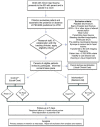Effectiveness of the head CT choice decision aid in parents of children with minor head trauma: study protocol for a multicenter randomized trial
- PMID: 24965659
- PMCID: PMC4081461
- DOI: 10.1186/1745-6215-15-253
Effectiveness of the head CT choice decision aid in parents of children with minor head trauma: study protocol for a multicenter randomized trial
Abstract
Background: Blunt head trauma is a common cause of death and disability in children worldwide. Cranial computed tomography (CT), the reference standard for the diagnosis of traumatic brain injury (TBI), exposes children to ionizing radiation which has been linked to the development of brain tumors, leukemia, and other cancers. We describe the methods used to develop and test the effectiveness of a decision aid to facilitate shared decision-making with parents regarding whether to obtain a head CT scan or to further observe their child at home.
Methods/design: This is a protocol for a multicenter clinician-level parallel randomized trial to compare an intervention group receiving a decision aid, 'Head CT Choice', to a control group receiving usual care. The trial will be conducted at five diverse emergency departments (EDs) in Minnesota and California. Clinicians will be randomized to decision aid or usual care. Parents visiting the ED with children who are less than 18-years-old, have experienced blunt head trauma within 24 hours, and have one or two risk factors for clinically-important TBI (ciTBI) from the Pediatric Emergency Care Applied Research Network head injury clinical prediction rules will be eligible for enrollment. We will measure the effect of Head CT Choice on: (1) parent knowledge regarding their child's risk of ciTBI, the available diagnostic options, and the risks of radiation exposure associated with a cranial CT scan (primary outcome); (2) parent engagement in the decision-making process; (3) the degree of conflict parents experience related to feeling uninformed; (4) patient and clinician satisfaction with the decision made; (5) the rate of ciTBI at seven days; (6) the proportion of patients in whom a cranial CT scan is obtained; and (7) seven-day healthcare utilization. To capture these outcomes, we will administer parent and clinician surveys immediately after each clinical encounter, obtain video recordings of parent-clinician discussions, administer parent healthcare utilization diaries, analyze hospital billing records, review the electronic medical record, and conduct telephone follow-up.
Discussion: This multicenter trial will robustly assess the effectiveness of a decision aid on patient-centered outcomes, safety, and healthcare utilization in parents of children with minor head trauma in five diverse EDs.
Trial registration: ClinicalTrials.gov registration number: NCT02063087. Registration date February 13, 2014.
Figures

References
-
- Faul M, Xu L, Wald MM, Coronado VG. Traumatic Brain Injury in the United States: Emergency Department Visits, Hospitalizations and Deaths 2002–2006. Atlanta, Georgia, USA: Centers for Disease Control and Prevention, National Center for Injury Prevention and Control; 2010.
-
- Kuppermann N, Holmes JF, Dayan PS, Hoyle JD Jr, Atabaki SM, Holubkov R, Nadel FM, Monroe D, Stanley RM, Borgialli DA, Badawy MK, Schunk JE, Quayle KS, Mahajan P, Lichenstein R, Lillis KA, Tunik MG, Jacobs ES, Callahan JM, Gorelick MH, Glass TF, Lee LK, Bachman MC, Cooper A, Powell EC, Gerardi MJ, Melville KA, Muizelaar JP, Wisner DH, Zuspan SJ. et al.Identification of children at very low risk of clinically-important brain injuries after head trauma: a prospective cohort study. Lancet. 2009;374:1160–1170. doi: 10.1016/S0140-6736(09)61558-0. - DOI - PubMed
-
- Pearce MS, Salotti JA, Little MP, McHugh K, Lee C, Kim KP, Howe NL, Ronckers CM, Rajaraman P, Craft AW, Parker L, Berrington de González A. Radiation exposure from CT scans in childhood and subsequent risk of leukaemia and brain tumours: a retrospective cohort study. Lancet. 2012;380:499–505. doi: 10.1016/S0140-6736(12)60815-0. - DOI - PMC - PubMed
-
- Mathews JD, Forsythe AV, Brady Z, Butler MW, Goergen SK, Byrnes GB, Giles GG, Wallace AB, Anderson PR, Guiver TA, McGale P, Cain TM, Dowty JG, Bickerstaffe AC, Darby SC. Cancer risk in 680,000 people exposed to computed tomography scans in childhood or adolescence: data linkage study of 11 million Australians. BMJ. 2013;346:f2360. doi: 10.1136/bmj.f2360. - DOI - PMC - PubMed
-
- Smith-Bindman R, Lipson J, Marcus R, Kim KP, Mahesh M, Gould R, Berrington de Gonzalez A, Miglioretti DL. Radiation dose associated with common computed tomography examinations and the associated lifetime attributable risk of cancer. Arch Intern Med. 2009;169(22):2078–2086. doi: 10.1001/archinternmed.2009.427. - DOI - PMC - PubMed
Publication types
MeSH terms
Associated data
Grants and funding
LinkOut - more resources
Full Text Sources
Other Literature Sources
Medical

